Last updated on October 26th, 2017
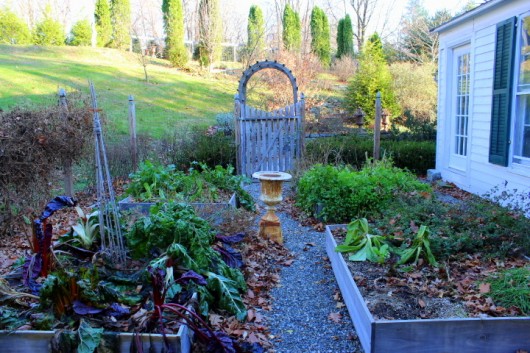 HOW’S YOUR YARD CLEAN-UP PROGRESSING? This morning I had a panic attack, after hearing that a deluge and a deep-freeze were headed to the Hudson Valley. The problem? I had not yet put my Herb Garden to bed. Consequently I leaped into action:
HOW’S YOUR YARD CLEAN-UP PROGRESSING? This morning I had a panic attack, after hearing that a deluge and a deep-freeze were headed to the Hudson Valley. The problem? I had not yet put my Herb Garden to bed. Consequently I leaped into action:
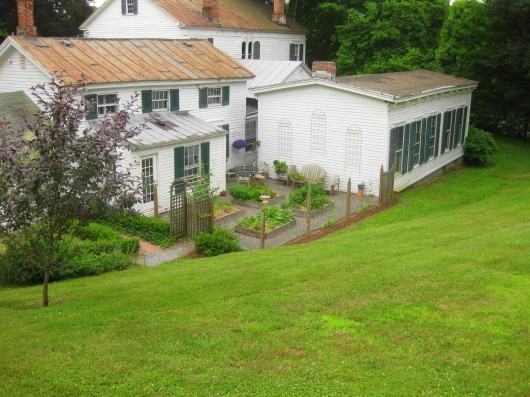 As most of you know, I designed my little patch for herbs in the nook created by two wings of the house. The garden is a sight to behold in spring and summer (you can tour the garden here). But it is definitely a sight to avoid after the first autumn frost.
As most of you know, I designed my little patch for herbs in the nook created by two wings of the house. The garden is a sight to behold in spring and summer (you can tour the garden here). But it is definitely a sight to avoid after the first autumn frost.
The clean-up procedure:
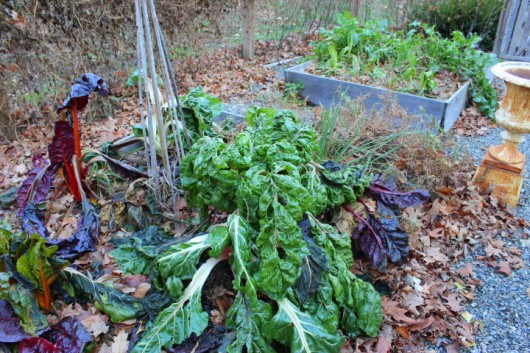 First, I pulled the frost-bitten Swiss chard…
First, I pulled the frost-bitten Swiss chard…
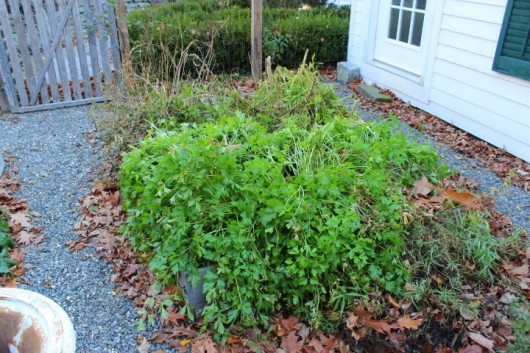 Then I uprooted the flat-leaved parsley. And the lemon verbena. And the tarragon.
Then I uprooted the flat-leaved parsley. And the lemon verbena. And the tarragon.
I’ve decided that tarragon is simply too weedy-looking for a raised bed. My plan is to winter-sow seeds of French tarragon in December or January, and then keep the plants confined to pots thereafter.
Why did I yank out the parsley? Because I’ve already preserved my winter-supply of the herb.
 From another bed, I harvested 12 turnips. These were planted in mid-August, and oh, how they grew. The roots are huge. But they are perfect for pizza.
From another bed, I harvested 12 turnips. These were planted in mid-August, and oh, how they grew. The roots are huge. But they are perfect for pizza.
Did you know that turnips, carrots, and parsnips — if thinly sliced and then sweetly caramelized in a hot oven — make a terrific topping for a white (no tomato sauce) pizza? Neither did I, until I tried such a root-veggie pizza from Baba Louie’s in Hudson, NY. ‘Twas delicious. (Update: Here’s my recipe for Root Veggie Pizza.)
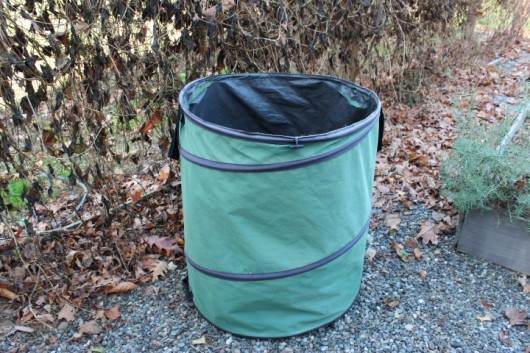 Clean up was made all the easier because of the collapsible bin you see pictured above. The bin is one of the best inventions ever. When fully open, it stands about 3 feet tall.
Clean up was made all the easier because of the collapsible bin you see pictured above. The bin is one of the best inventions ever. When fully open, it stands about 3 feet tall.
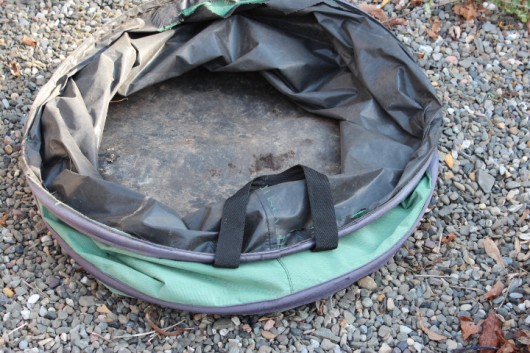 When collapsed, it stands only 6 inches tall.
When collapsed, it stands only 6 inches tall.
Would you like to see that again?
 If you don’t already possess one of these shape-shifting receptacles, by all means obtain one. You’ll find it much less cumbersome than a wheelbarrow.
If you don’t already possess one of these shape-shifting receptacles, by all means obtain one. You’ll find it much less cumbersome than a wheelbarrow.
 And here are the raised beds after clean-up. But they aren’t quite ready for bed yet. They need a blanket of shredded leaves.
And here are the raised beds after clean-up. But they aren’t quite ready for bed yet. They need a blanket of shredded leaves.
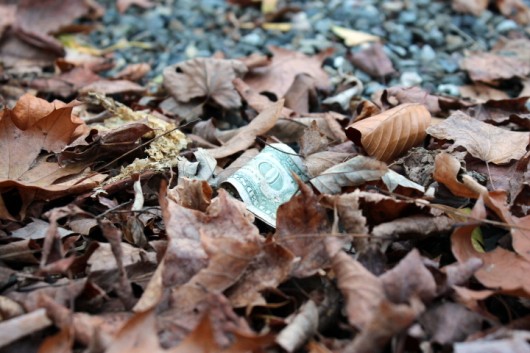 And speaking of leaves, do you see what I see? Yes — it’s a dollar bill, nestled among the leaves that drifted into the herb garden. Obviously it came from the money tree located in my woodland.
And speaking of leaves, do you see what I see? Yes — it’s a dollar bill, nestled among the leaves that drifted into the herb garden. Obviously it came from the money tree located in my woodland.
The money tree is a slow-grower. It can take years to produces any bills. And those bills are limited to ones, not fives. Fortunately a team of hybridizers are working to correct this flaw.
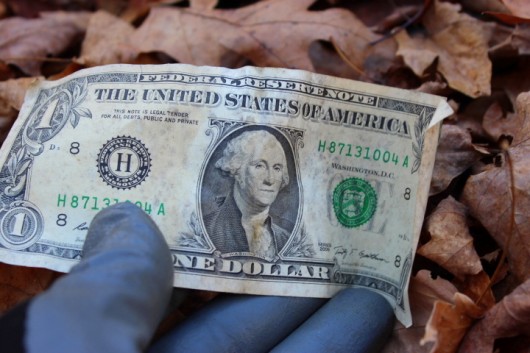 Okay. I don’t know where that cold cash came from. But finding it made my clean-up efforts seem even more worth while.
Okay. I don’t know where that cold cash came from. But finding it made my clean-up efforts seem even more worth while.
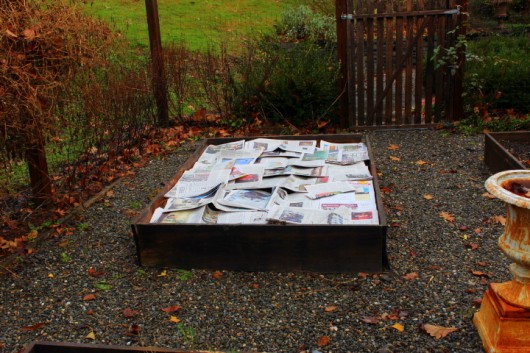 Before mulching these beds with shredded leaves, I laid down a layer (4-pages thick) of newspaper. The newspaper insures that perennial weeds will not emerge in spring.
Before mulching these beds with shredded leaves, I laid down a layer (4-pages thick) of newspaper. The newspaper insures that perennial weeds will not emerge in spring.
You can always wait until spring to newspaper-mulch a garden. But why put off until tomorrow what you can do today?
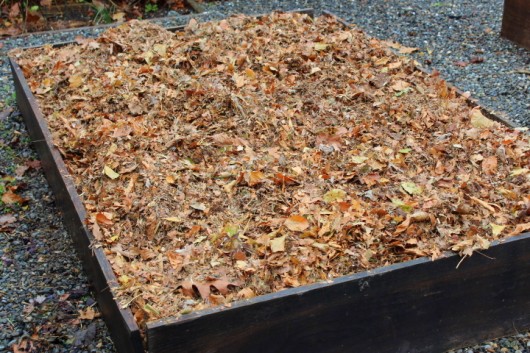 As a final step, I topped-off the raised beds with shredded leaves. Shredded leaves contribute myriad nutrients to the soil. Leaves make a garden water-wise, too. You see, leaves hold many times their weight in water. Of course they also improve soil texture, while providing food for worms and other beneficial organisms.
As a final step, I topped-off the raised beds with shredded leaves. Shredded leaves contribute myriad nutrients to the soil. Leaves make a garden water-wise, too. You see, leaves hold many times their weight in water. Of course they also improve soil texture, while providing food for worms and other beneficial organisms.
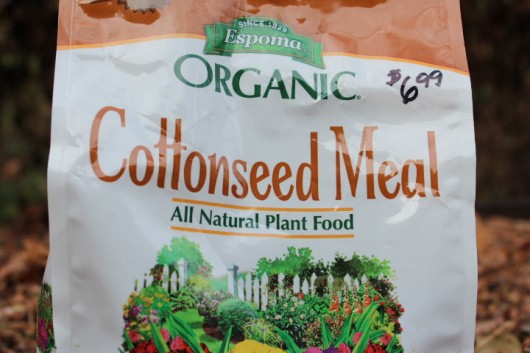 To help the leaves break down, I sometimes sprinkle a handful of organic cottonseed meal over each 6×4 bed. Cottonseed meal is almost all-nitrogen. It is nitrogen plus carbon (from the dried leaves) that produces heat. However, if the weather is already frigid, it makes little sense to add cottonseed meal at this time. You can always add it in early spring if your own leaves have not decayed sufficiently.
To help the leaves break down, I sometimes sprinkle a handful of organic cottonseed meal over each 6×4 bed. Cottonseed meal is almost all-nitrogen. It is nitrogen plus carbon (from the dried leaves) that produces heat. However, if the weather is already frigid, it makes little sense to add cottonseed meal at this time. You can always add it in early spring if your own leaves have not decayed sufficiently.
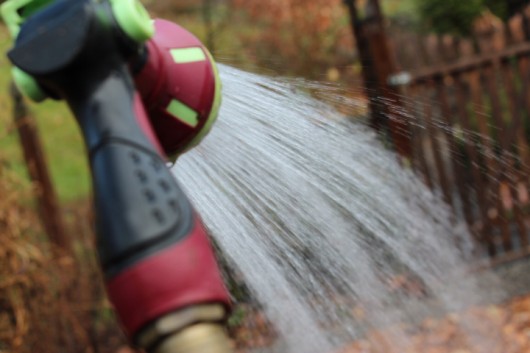 In any event, after laying down the leaves, I always spray them with water. Once moistened, shredded leaves will not blow away in a strong wind.
In any event, after laying down the leaves, I always spray them with water. Once moistened, shredded leaves will not blow away in a strong wind.
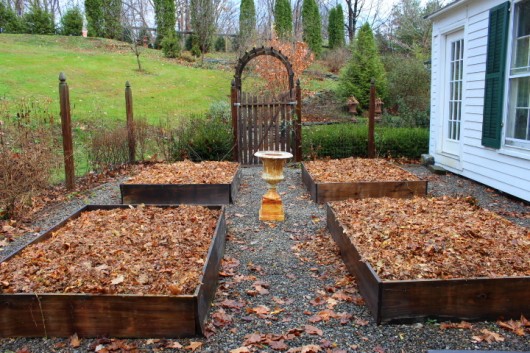 And that’s the herb garden, all tucked in for winter. In spring I won’t have to do a lick of work to prepare the beds for planting. I can simply insert my seeds or seedlings into the beds. And then I can sit back and enjoy a martini.
And that’s the herb garden, all tucked in for winter. In spring I won’t have to do a lick of work to prepare the beds for planting. I can simply insert my seeds or seedlings into the beds. And then I can sit back and enjoy a martini.
Are you rushing to complete your garden chores in advance of frigid weather? You have my sympathy. And my encouragement.
Don’t miss anything at A Garden for the House...sign up for Kevin’s weekly newsletter.
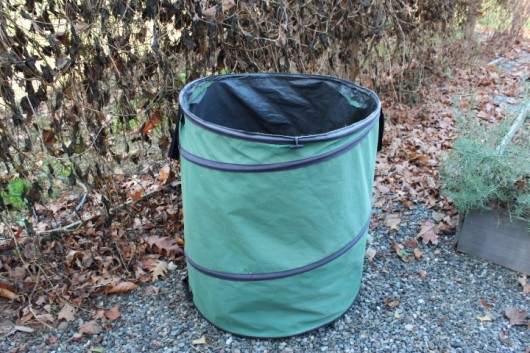
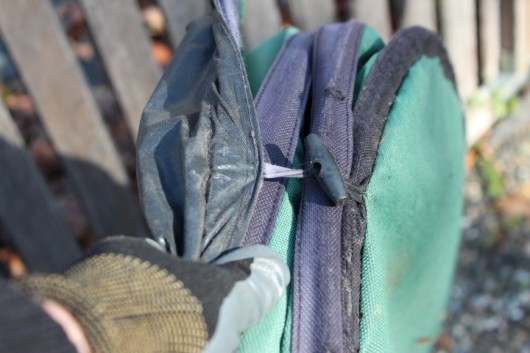

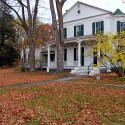


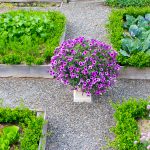

Barbara S says
Hello Kevin:
It was time out here in the greater Sacramento Area to clean out the garden beds this past weekend. I had a few good sized green tomatoes left on my vines and brought them in to see if they will ripen and then away went the vines. I still have carrots growing so I shall see how they turn out. Thank you for your posts and photos.
Kevin Lee Jacobs says
Hi Barbara S – Your green tomatoes will definitely ripen if you place them in a brown paper sack with a banana. And how lucky you are to have a lengthy growing-season — here, gardens are mostly-finished in September!
Kelli Patton says
I shredded MOUNTAINS of leaves with my fabulous new Shop Vac Yardman (a major STEAL at Sam’s Club)- and turned them into 7 bags of AWESOME! I added a thick layer to all my raised beds (with some high nitrogen organic fertilizer) and saved three bags to mix with grass clippings in the composter come spring/summer. If only I had more! I offered to take away any bags of leaves from neighbors and friends, but, alas, the leaf blower has replaced raking and bagging in most homes around here. If I had more bags, I would save them and mulch all my flower beds in the spring. The finely shredded leaves were very attractive!
Kelli Patton says
*Oops! It’s actually the Shop Vac mulcher yard vac!
Kevin Lee Jacobs says
Kelli Patton – Kudos to you! Your shredded leaves will feed the worms and increase your garden’s moisture retention.
Cary Bradley says
Got boysenberry vines corralled and covered with shredded leaves, hopefully, cozy for the winter. Garlic bed is ready for recruits, but ran out of steam. Hopefully, will get planted today before rain hits hard. If not, will hopefully get a chance to pop them in if this hard freeze, thaws enough. Hate pulling Swiss Chard, but know I must. Will probably harvest any leaves I can salvage and just let the plants die a noble death in the beds for now. Thanks Kevin, for your seasonal reminders and especially for your caution about this coming hard freeze!
Suzanne says
I have tons of oak leaves which I hesitate to put on the raised beds because of the acid level in the leaves. What is your opinion about using them in the vegetable garden? It seems a shame to put them in my “long term” compost pile.
I live in the foothills of the Sierra Nevada Mts. above Sacramento. We get an occasional dusting of snow; the temperature in my yard does go below 32 in the winter, but nothing like you experience in NY. I can’t imagine frozen ground!!!
Kevin Lee Jacobs says
Hi Cary – There is nothing like the threat of frozen ground to get a gardener hopping!
Hi Suzanne – Good news for you: It’s a myth that oak leaves are too acidic for veggie beds. I use them, and so can you. Just be sure to shred them well.
Sheri says
Kevin thanks for the tutorial! I just did a similar project here in Wisconsin. We were lucky to have a nice big rainfall over the weekend, and now that frost. After such a dry summer I was happy the perennials and trees got a big drink.
My question is about your compost pile. I have a nice organized compost bin where our food scraps go. It yields a surprising amount of lovely compost which we put back on the gardens spring and fall. But all the dead stuff I trim off plants is too much for the bin, and I think overwhelms it. Do you have a separate compost pile for plant trimmings? And if so, can you tell us how you manage it? We currently tend to dump the twigs and weeds in a large grass and tree-filled swale between our yard and the neighboring research park. The grasses are high and it’s a nice hiding place for stuff like that without looking junky. But I’d love advice about what to do with it in a more organized way?
We’re also in the process of adding more flower beds, which means we have been pulling up grass patches. Guess where else we toss those lumps of sod? Yes the swale now has a small hill in it. Hmm.
Terry says
We are supposed to have a little sun the next couple of days, so I need to drag myself out there and rake up all those leaves and get them into my garden! Thanks for the reminder!!
Bill C, says
Thanks for the info. Was planning on the shredded leaves but now will use newspaper also.
Sue Wein says
Good Job, Kevin…looks great..got a lot done yesterday in the warmth of the day..kept thinking about you saying how it should be left like you want to find it in the spring…well, I am sure I won’t find it exactly like I would hope but…I appreciate all the encouragement and advice!
trilium says
We did that this year! Also put shredded leaves in flowerbeds hoping it will enhance the soil. Mother Nature happened to help out by soaking the ground!
I’m already starting to collect milk containers for winter sowing seeds again this winter. I’m still in awe at the ease and beauty of growing seeds like this.
Mary Brotherton says
Your blog is such a delight to read and see!
ellen tinder says
to barbara in sacramento- if you wrap your tomatoes in newspaper and put them in a cool place they will ripen and you can have homegrown tomatoes when everyone else has to suffer with store bought.
Bob Klaassen says
I am in the makeing of two raised garden beds 12feet long by 4wide and two feet high. I broke my back a few years ago so need them high so I don`t need to bend as much I am just waiting for 8cubic yards of soil for them I love all veg`s and tomatoes, carrots beets ,turnips, cuc`s beans. What ? I also have lot of leaves but do not have a sheder. Thank for some help.
Linda J. says
I just discovered your blog . . . . and LOVE it. I’m new to the veggie gardening world — actually new to gardening, period. Right now I’m preparing beds for planting by removing grassy sod from my back yard, with the help of another person.
Since I live in the Pacific North West, our winters are relatively mild . . . the occasional dump of snow but mainly rain. I’ve been told that I can have a winter crop of such things as spinach. What advice can you give me?? Thanks.
Suzanne K says
To Bob, regarding a shredder. I don’t have one either but picked up a fairly good trick that helps (if not quite as good). I put 10-12″ of leaves in the bottom of a heavy duty trash can, metal if possible, and then use my weed eater to chop the weeds up in the trash can. Almost like a blender, up and down and around. Don’t do too much at a time or they won’t all get done. Do a layer, get it chopped up, add another layer and repeat. As I said, not quite as good as a shredder, but sure better than nothing, and using something most of us already have on hand.
Yvonne says
I make a tomato pie for Thanksgiving and am happy to say we still have fresh Roma tomatoes at the markets in Charleston, SC. None in my garden but some farmers are still harvesting. Of course, we NEVER have a white Christmas and August/September are just miserable, having late season tomatoes doesn’t make up for that!!
John says
Advice for Linda J.: No need to remove the existing grassy sod! Just lay a think layer of newspaper over the sod, then pile up a few inches of topsoil and top with a think layer of shredded leaves or mulch. By spring, the grass will be dead and decaying (especially in your climate) and you can plant directly in the raised bed. (If you have the topsoil to add, you can go ahead and plant relatively shallow-rooted veggies such as spinach and lettuce for a winter crop. If your winter turns out more severe than normal, the new plants will still get a head-start and you’ll be harvesting spinach and lettuce way earlier than what you’d get with spring sowing.) I’ve done this for years. Our September planted spinach is already getting harvested, but will really be great in March.
Wolfgang says
Kevin,
I like the idea of newspaper before the leaves but will have to institute that technique next year. I cover all my raised beds already and took the last pile of leaves in our driveway to my second leaf compost pile. We have the local village delivery a load of leaves after they suck them up from the edge of the road. The guy warned me that the leaves are compressed and could total 30 cubic yards. I said I am okay with that. Lo and behold the pile was enormous in the middle of our driveway when delivered in early October and it took until today to get all the leaves in back. Now I have enough leaves for the next year. Ask and you shall receive in abundance!!!!!!!!!
Deb Nelson says
I had already “put my garden to bed” a few weeks ago, we have had some heavy frosts. Although I have to say, I cut my 3 artichoke plants back like you suggested and mulched them very deeply with some straw (that I had used as another planting experiment) and they have grown back up through the straw about 6-8 inches!! They want to live!! I hope they do that in the spring!!
I put all of the leaves from the front yard on the beds, my son just went over them with the mulching lawn mower and we scooped them up to put on the beds. I plan to get a load of horsey poop from my boss when we get the truck back on the road, it decided to die about the time the garden was done. 🙁 I would also like to get a load of topsoil to add to the mix and deepen the beds, I want them to be REALLY raised.
My hope for next year is to turn at least one of the beds into a cold frame bed for some winter greens.
Thanks so much for all the advise you give!
Azri'el says
I had a local tree trimming company drop off wood chips at my place last spring and while keeping it moist and adding household compostables, have a nice batch to spread over the gardens, along with tree leaves I mulched up with an old fashioned human powered mower. Some of the composted chips from a year before, I dug in before layering the newer mulch. I also piled mulch around my herbs that I want to winter over, like the rosemary , oregano, and sage. That way, even if it is an extra harsh winter, the base of the plants will do just fine and sprout out again in the spring. I am thinking though of making wooden boxes for the rosemary and load them up with mulch. Will see.
Elaine says
Kevin I have a question for you…a few years ago someone told me NOT to mulch my beds with leaves because the leaves can carry a disease that affects tomatoes. Can you enlighten me on this. Thanks
Kevin Lee Jacobs says
Hi Elaine – Shredded leaves from deciduous trees will not harm tomato plants. The biggest threat to tomatoes is late blight — a fungus that overwinters on unharvested potatoes.
Riversana says
I’m still waiting for the leaves to finish dropping before attempting to gather them up and use them for mulch. The difficulty will be convincing my free-range chickens that mulch needs to stay where I put it! I just received my Christmas present from my mom, who generously shared with me a third of her fall bulb order from Van Englen’s!! So now I have about 150 bulbs to plant–tulips, muscari, daffodils, etc. Spring will be wonderful!!
Karen says
Had to laugh when I saw this, I did the EXACT same thing on Sunday. I even have the same collapsible green garden bin! I did use cardboard instead of newspaper – which works at least as well.
Denise in NJ says
I must be a glutton for punishment! I have three 4×8 raised beds and bought “greenhouse” tops for them. One bed is just for herbs, and with the top I have fresh herbs all year. The second one contains garlic through the winter, and the third carrots and kale. A fourth 6×6 bed has a full height “greenhouse” cover and keeps my potted herbs and figs cozy and I also grow salad greens throughout the winter in there.
Constance Clark says
I planted a bunch of stuff rather late in the season and they are still growing (hoping the brussel sprouts and turnips ever happen). I have one raised bed and a bunch of containers. Still learning about this gardening stuff and having a blast doing it!
S. Taylor says
Here in middle Tennessee, we are just cooling down to the point that the gardens are damaged but those Snow Peas are still food of the Gods!
Definitely working my main garden this way next week. Have read about adding cornmeal. Do you suppose it has similar benefits?
Chi says
Kelvin,
I just started gardening this spring. I built a raise bed with leaves, peat moss, clippings and triple mix soil. The plants grew very well until I found tons of transparent eggs and slugs. They touch all of the plants. Not a single plant had no holes. I am so depressed. Then, I find out may be because it is a shade garden, doesn’t have a lot of sun.
I want to top up the raised bed like you did. But I don’t know does it work with a shade garden?
Http://wiki.otaku-Irc.fr says
You are so awesome! I do not believe I’ve read through something like that before. So nice to find somebody with original thoughts on this subject matter. Really.. thank you for starting this up. This web site is something that’s needed
on the web, someone with a little originality!
Sara in Indiana says
Your herb beds look so nice–wish I had done my raised beds that way in the fall–is it too late to add newspapers, shredded leaves, and cottonseed meal to the beds in early to mid-March? Also, how thick of a layer of newspapers do you put down? Do they break down enough over the winter so that your new seeds’ roots don’t hit an impenetrable paper wall? Thanks for all the wonderful advice, photos, and recipes–I look forward to your email every week!
Lori says
Sara in Indiana has asked my question! I’ve used newspapers as mulch before and found them to be quite unchanged by season’s end. Will they break down enough to be worked into the soil by spring?
Kevin Lee Jacobs says
Hi Sara & Lori – Wet newspaper can be pierced very easily. Consequently, if the paper hasn’t broken down sufficiently by planting-time in spring, I simply use a trowel to poke-out an opening for each seedling. To plant seeds, I use a trowel to open up a row in the paper.
Sara – You can create a newspaper weed-barrier anytime. It’s just easier to do in autumn or winter, before you’ve started to plant. I lay down newspaper 5-10 pages thick. Impossible to say if your shredded leaves will break down in time for planting. But you can always move them aside when you need to poke out a row for seed-planting. (Hope I answered your questions!)
Mark S. Urban. LTC Ret says
I bought a leaf blower / shredder last fall from ALDI’s That was a great investment ($40) as it will blow them leaves in a pile and then adding an attachment will suck em up through the light weight shredder into a bag. The fine shredded leaves went right into the raised beds to prevent those over winter weeds that collect and show up in the spring. I also mow the street in the fall where all the leaves collect before the neighbors rake them into piles for the city to pick up. You can never get enough “brown ” composting stuff in the summer.
Tammy says
Kevin, I’ve just purchased some cottonseed meal. When my raised beds finally emerge from under the 3 feet of snow still on them, which could be April at this point, if my shredded leaves haven’t broken down enough, is there a time in spring that it’s too late to add the cottonseed meal? I’m wondering if it will have a negative effect on any of my vegetable plants, which would normally go in the ground around the last week of May. Thanks for any advice you have on this!
Karen Carpenter says
Hi Kevin,
Can this technique also be used for my vegetable garden, or only my herb garden?
Thank you
Kevin Lee Jacobs says
Tammy – Organic cottonseed meal is mostly nitrogen. A light sprinkling won’t negatively affect your veggie plants.
Karen – Along with my Herb Garden, in fall, I always place shredded leaves in my veggie garden beds. The leaves eventually break down and turn into leaf mold. (Leaf mold is the best soil amendment on earth.) I only apply newspaper to beds that are particularly prone to weeds. Four sheets of newspaper makes a terrific weed-barrier.
Karen Carpenter says
Thank you Kevin.
Georgia Lewis says
Hi: Mulching is new to me, so this question may seem silly. While reading your article on putting your raised beds to bed, I wondered about the process of laying down newspaper before putting the leaves down. If the leaves are eventually going to be part of the soil, won’t the newspaper prevent that by being layered in between the old soil and the leaves?
Katherine Cooley says
Hi Kevin
Looking forward to dressing my raised beds with newspaper and shredded leaves as you describe. Is it ok if grass clippings are part of the shredded mix or must it all go into the mulch bin?
Kevin Lee Jacobs says
Hi Georgia Lewis – Unless you pile them too thickly, the leaves should break down over winter. Mine certainly do. The newspaper eventually decomposes, too. (If you’d prefer, you can omit the paper.)
Katherine Cooley – If you don’t use chemicals on your lawn, by all means add the grass clippings to your shredded leaves. The leaves are carbon; the grass is nitrogen. Excellent combination!
Lisa Smith says
Can i add casoron into my vegetable beds to not get weed over winter, or does that harm it. Also I got worms inside the stems of my raspberry plants this year , should I cut it down all the way for the winter or just thin it down , do I need to water my fruit trees over the winter, they are not fruit bearing yet.
Thank You.
Letty says
I am new to gardening and was wondering if now is a good time to do this in Texas? Should I do this to a new raised bed before planting?
Laura says
Hi,
I just ran across your website today. It is about time to get our raised beds ready for ‘bed’ here in Illinois. My question has to do with black walnut trees. We have several of them in our yard. I don’t think they are okay to use as a mulch due to toxicity, but maybe not. Do you know? Thanks.
Kevin Lee Jacobs says
Hi Laura – My best advice is this: Contact your local cooperative extension concerning black walnut leaves. I know the leaves lose their toxicity during composting, but just how long they need to compost I’m not sure.
anne says
Enjoyed you pictures. I plan to do this here in nc. My garden spots are full of grass. do i need to remove the grass first?
Ann Malloy says
Kevin
This was my first year with raised beds. I think we have a problem with the shredded leaves. You see we have mainly those awful oak trees. We had our soil tested by the local state extension service a while back. We have only owned this property a couple of years and have not been able to get grass to grow. We were told that the oak leaves are very acidic and we have been adding a ton of lime to help neutralize the soil. It seems like adding oak leaves to my raised beds may also cause problems there? Thanks for any insight.
Ann
mary says
Kevin – I love your blog and was glad to review this blog and get the tip on additing nitrogen in the form of cottenseed meal. I have added many bags of mulched leaves and have more to go. I live in Texas and have clay soil but with leaves and woodchips I am transforming my soil slowly over time. Thanks for sharing with us.
doc says
trying to winterize new raised asparagus in nh
Connie Chard says
Hey Kevin….
What is the manufacturer of that collapsable bag..there are so many I would prefer a recommendation from you..thank you!
Roberta Adams says
Kevin,
Can I use the same leaf/newspaper process on my perennial flower garden?
Dreaming of SPRING already,
Linda BP says
Every time I read about using leaves for mulching, I wish I could. I have two problems about the leaves near me, that I could turn to mulch. Some are from Walnut trees, which as I understand it, may poison the soil for other plants. Some are hackberry leaves that are covered with galls. As I understand it for these trees, even though the trees grow fine, there is something in the soil that makes these galls come back year after year. The nursery told me years ago when we bought the house that as long as there were other trees in the neighborhood that had galls, it would be very hard to disinfect the soil.
In your opinion, am I right to avoid using these leaves as garden mulch?
Also, when using the newspapers each year, they never seem to break down well, and I end up removing them instead of leaving them. Would the cottonseed meal help break down the newspapers even if I am not using leaves?
Thanks!
SQWIB says
Thank you I enjoyed your post.
Just a heads up. I wouldn’t pull the herbs from the soil, cut them back, leave the trimmings in place then add your leaves (no paper needed). By uprooting the plants you disturb the Soil Food web too much, there’s no need to remove the trimmings to a compost heap. Leave them compost in place.
Rose says
Will powdery mildew on leaves damage the raised garden?
Hansel says
Nice, great ideas there Kevin! I learned a thing or two.